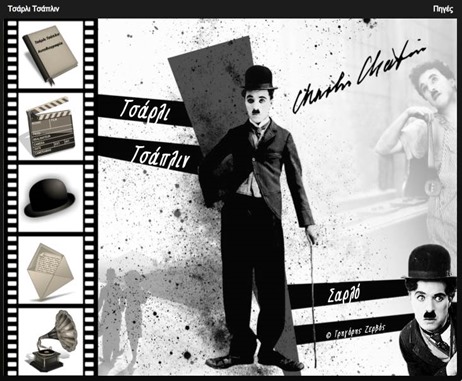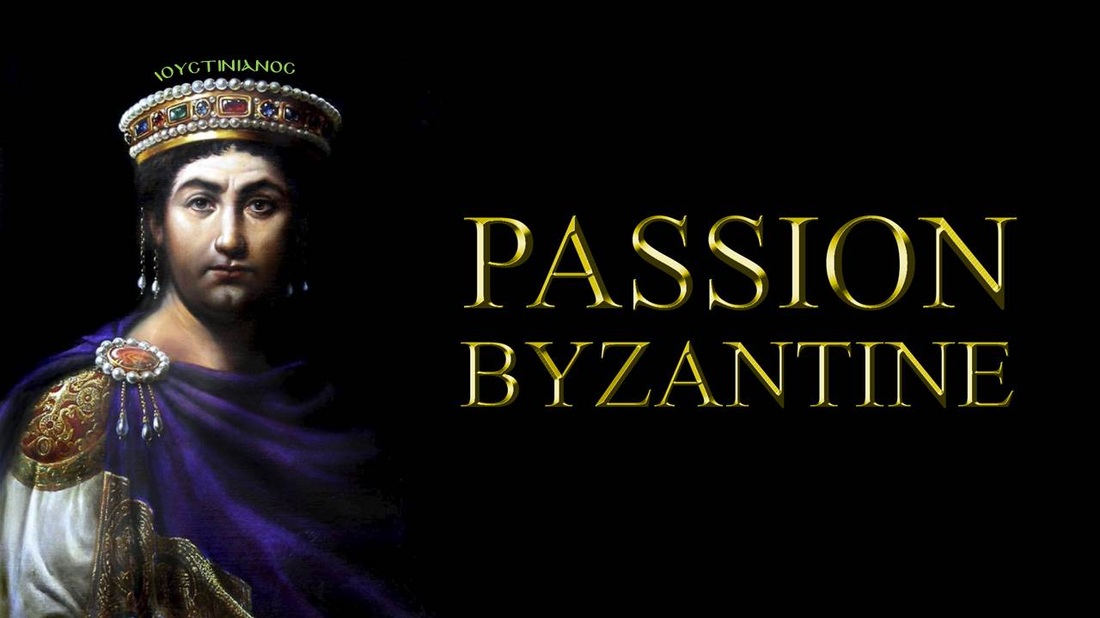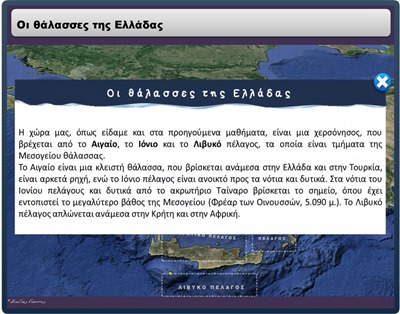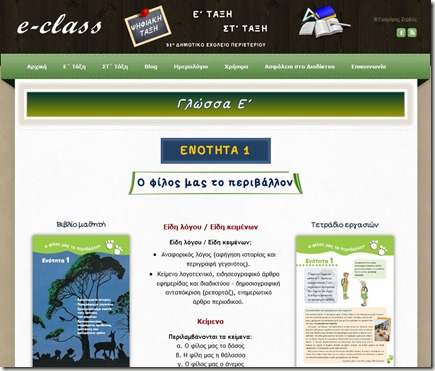- Η τεχνολογία αιχμής σε ένα σχολείο είναι ο καλός δάσκαλος.
- Το ζήτημα δεν είναι περισσότερη ή λιγότερη τεχνολογία, αλλά η αποτελεσματική χρήσης της.
- Με τις Νέες Τεχνολογίες δημιουργούμε την επιθυμία για μάθηση, ενισχύοντας τη συμμετοχή και τη δημιουργικότητα των μαθητών.
- Η δόμηση της γνώσης, η κριτική σκέψη, η συνεργασία, η επικοινωνία και η δημιουργικότητα αποτελούν τις δεξιότητες που πρέπει να αναπτύξουν οι μαθητές στην εποχή μας.
Γρηγόρης ...δάσκαλος...
4 Σεπ 2016
Πέντε χρόνια ψηφιακής δημιουργίας…
15 Ιουλ 2014
13 Ιουλ 2014
Τσάρλι Τσάπλιν
Ο Τσαρλς Σπένσερ Τσάπλιν ο νεότερος (Charles Spencer Chaplin Jr) ήταν ένας από τους σπουδαιότερους και διασημότερους ηθοποιούς και σκηνοθέτες του κινηματογράφου όλων των εποχών.
Από το 1914 και μετά, γύρισε πολλές ταινίες στην Αμερική, κυρίως του βωβού κινηματογράφου, και έγινε διάσημος σε όλο τον κόσμο.
Χαρακτηριστικός είναι ο ήρωας που εμπνεύστηκε, ο Σαρλό, ο πρώτος αναγνωρίσιμος χαρακτήρας του σινεμά, ο γνωστός μικρόσωμος άκακος αλήτης, με το καπέλο, το μπαστουνάκι, τα φαρδιά ρούχα, τα τρισάθλια λοξά παπούτσια και το μουστακάκι-βούρτσα.
Κάντε κλικ στην εικόνα, για να μάθεις περισσότερα για τον Τσάρλι Τσάπλιν. Εδώ μπορείτε να βρείτε και το ποίημα του Νικηφόρου Βρεττάκου "Γράμμα στον Τσάρλι Τσάπλιν", πολλά στοιχεία για τη ζωή του και το έργο του και να δείτε αποσπάσματα από επιλεγμένες ταινίες του.
11 Ιουλ 2014
PASSION BYZANTINE
Ο Antoine Helbert από το Στρασβούργο της Γαλλίας είναι ζωγράφος, γλύπτης, εικονογράφος, γραφίστας, σκηνογράφος όπερας, ψηφιακός καλλιτέχνης κ.ά.
Πριν μερικά χρόνια έλαβε ως δώρο από τη μητέρα του ένα βιβλίο για το Βυζάντιο και τόσο εμπνεύστηκε από αυτόν τον μυστηριώδη πολιτισμό που αγνοούσε μέχρι τότε, που δημιούργησε μερικούς ψηφιακούς πίνακες εμπνευσμένους από αυτόν.
Τους ονόμασε μάλιστα με το γενικό τίτλο «Βυζαντινό Πάθος» (PASSION BYZANTINE), ενώ απεικονίζουν βυζαντινή αρχιτεκτονική, πορτρέτα και στιγμιότυπα καθημερινής ζωής.
8 Ιουλ 2014
7 Δεκ 2013
Τεχνολογία & μάθηση – Πέρα από τα σύνορα της τάξης (eLearningExpo)
Με την εισήγηση "Τεχνολογία και Μάθηση: Πέρα από τα σύνορα της τάξης” συμμετέχουμε στην e-Learning Expo.
Σάββατο 14/12/2013 14:35 Αίθουσα 1Α. Συνεδριακό κέντρο ΕΕΔΕ (Λεωφ. Ιωνίας 200 και Ιακωβάτων 61, Αθήνα).
Η δημιουργία πολυμεσικών εφαρμογών, μέσω του PowerPoint, μας δίνει την δυνατότητα να υπερβούμε την απλή “διεκπεραίωση της ύλης” και μέσα από την ανάπτυξη εκπαιδευτικών εφαρμογών ασκούμαστε στο διδακτικό μετασχηματισμό του περιεχόμενου στη κατάλληλη μορφή, δόμηση και οπτικοποίηση. Ο μαθητής προσεγγίζει το μάθημα ως ενεργή διαδικασία και ο εκπαιδευτικός προετοιμάζει την διδακτική του παρέμβαση που βασίζεται στη χρήση των ΤΠΕ, διευρύνοντας τη κλασική διδασκαλία. Με δημιουργία ηλεκτρονικών μαθημάτων ο μαθητής μπορεί να αποφασίζει πότε και πόσο θέλει να μάθει. Ο ρυθμός μάθησης είναι ελεγχόμενος, η μαθησιακή διαδικασία μπορεί να επαναλαμβάνεται και η παρουσίαση (PowerPoint) να είναι πολυμεσική, πολυτροπική και διαδραστική.
Οι εφαρμογές των ΤΠΕ που βασίζονται σε αρχιτεκτονικές υπερκειμένου και υπερμέσων καθιστούν εφικτή την «ανοιχτή» και «ευέλικτη» μάθηση. Τα ηλεκτρονικά μαθήματα που σχεδιάζονται με παιδαγωγικά κριτήρια μπορούν να προσφέρουν κίνητρα, ευκαιρίες και δυνατότητες στους μαθητές. Η σχεδίαση και ανάπτυξη ηλεκτρονικών μαθημάτων με τη χρήση του PowerPoint, αποτέλεσε για μας τον σημαντικότερο παράγοντα επιτυχίας της χρήσης των ΤΠΕ στην εκπαιδευτική μας διαδικασία. Τελικά δεν είναι αυτό που η τεχνολογία καθιστά δυνατό, αλλά είναι αυτό που η τεχνολογία καθιστά εύκολο.
30 Νοε 2013
Συνέντευξη στην εταιρεία Articulate
Η συνέντευξη που έδωσε ο συνεργάτης και φίλος, Γιάννης Σουδίας, στην εταιρεία Articulate, που ειδικεύεται στο e-learning, σχετικά με τα ηλεκτρονικά μαθήματα που δημιουργούμε με το Articulate Storyline.
My name is Maria LeStage and I work on the Marketing team at Articulate. I love the work you're creating with Storyline. I'd like to know a little more about your projects to see if they would be good for a case study to highlight your work with Articulate products. Can you please give me a little more background on the projects? Such as, what the objective is for the project, what the problem is you're trying so solve, why you chose e-learning to solve it, and how specifically Storyline helped you solve the business problem — those are a great start, and please feel free to include any background or contextual information about your projects and links to your work as well.
Μy complete name is John Soudias, I am a teacher in elementary school and I teach children between ages 10 and 12.
Two years ago I started along my cooperator Grigoris Zervos, who is also a teacher, creating a digital learning platform, with which students can learn their lessons at home.
In fact we used the method of Blended Learning. One part of this method is used into the classroom and the other one is used at home by each student. In order to be a successful method we had to create our own e-learning courses. This sort of courses attract the interest of students and many times boost experiencial learning. Until recently we used PowerPoint as the main tool for e-learning courses and we still use it in several cases. By having consumed all its possibilities, we were looking for a tool with endless interactive possibilities. This tool we were looking for, was discovered six months ago and it was Articulate Storyline. We use Storyline for creating e-learning courses as multi-media (flash, pictures, sound, video, text, etc) and especially interactive.
Course example: In our language book we have the lesson “Trip with an elephant” and Storyline gave us the opportunity to create a project.
Specifically: we talked about Jules Vern book “Around the world in 80 days”, we learned about the heroes, we saw the trip, we travelled along with them through movies, we learned about the use of means of transportation of that era and finally we wrote our own story. These were the aims of this lesson which were successfully achieved by the use of Storyline. My use of non-traditional ways to navigate between objects and characters stimulates the students interest. The use of Storyline makes this exceptionally easy.
Students were amazed by the way this lesson was taught and especially by the fact that they can use endlessly e-learning through our web site.
Personally for me, Storyline is a unique tool for learning because I can create “Digital Books” that boost students interest. I have created a small series of these lessons which students consider them to be important tools for learning.
In every e-learning course (Storyline) my teaching aim is different and is specified by the books we use at school. Sometimes my aim is simply: understanding the lesson (taxonomy Bloom) and sometimes my aim is evaluation or composure. This Maria, is determined by what the teacher has in mind for teaching.
This is terrific information. It sounds like you and your colleague Grigoris Zervos has successfully introduced a blended learning model at your school, and it is being received well by your students and faculty alike. That's great news! I've been able to translate some of the web-based info you've sent me, and for the course demos I'm following along with the navigation and interactive elements even though I don't know what the words say. But that's OK, the images are a great guide! Beautiful work and composition throughout. I have some more questions to help unearth a little more of the story here. I hope you don't mind if I just list those out here:
Why did you decide you wanted to introduce e-learning (digital learning platform) to your students?
We live in the age of learning via technology and social media. This procedure shouldn’t be limited in a classroom anymore. All thought, here in Greece we don’t have the necessary tools inside the classrooms. For something like this, we decided to support this effort at home. One student - one pc (1:1) at home. Knowledge and learning outside the limits of school.
Was there an objective to your blended approach -such as, to improve test scores, or help students get into better middle/secondary schools? Were you trying to solve a problem? Or was it simply about integrating digital tools into the curriculum?
It’s a compilation of the above, depends on the goal we set everytime. Firstly it was the contact with digital tools, then learning to work with them and finally assessing this effort. The biggest effort was to create online courses with multimedia (videos, sounds, interactions, simulations, hyperlinks etc.). The most general goal is to support courses online.
How has Storyline helped your students?
It offers the interaction and the environment for a course to be created with the variety of goals, fully digital. For example, in History and Geography, students get fascinated with the courses in Storyline. We call these “digital books”. They like the fact that they can use them anytime at home without the presence of a teacher like they think.
How were students performing in the previous teaching methods, before you introduced blended learning?
They used to get tired easily and lose their interest. Now they are looking forward to the digital courses we create and also some of them ask to present by themselves in the classroom instead of me.
Can you tell me about a specific project, challenge, or instance where Storyline let you do or create something you could not do/create without the software?
Such as, using an interaction type or other instructional design requirement that is unique to Storyline, or that it helped you create faster to meet a deadline, etc. Storyline has a unique ability to be very fast in the creation of a simple interactive form and also specialized for those who look for more. I love Lightbox and state moreover I feel like home, due to the fact that its graphical environment is like PowerPoint. In the last e-mail I referred on a project like this. Almost everything I’ve done wouldn’t have had this functionality without this program. In my last project I’m trying to imitate Studio’s 13 ImageZoom. Check here.
What products, besides Storyline and PowerPoint, do you use to create courses?
I’ve used only iSping Suite.
Did you try or consider other products? If so, which ones?
I’ve tried “Captivate” but I got scared when I entered its graphical environment and I left it. I’ve also tried “Lectora” but I didn’t find anything interesting. My philosophy is that if in the very first minutes the tool doesn’t attract you, you leave it and look for something else. Besides I’m a teacher and I started using e-learning because of the present educational needs. There is no time at all.
How long, on average, did it take you to create each course?
Over four days. Some complicated courses needed almost a month. Like this one.
John a couple more questions for you.
Do you have any metrics to show the scale/reach of your work? Meaning, how many students have taken your courses so far? How many do you hope to reach? How large is the school? By how much have these courses improved their performance?
The website that I use is simple and does not give me these metrics opportunities. The only thing I know is that last year I had 700 visitors and now I’ve reached 4,000 visitors per day. It’s a huge number for a Greek educational website. Part of the success is definitely own to Articulate.
I can only say for sure that my students’ interest for learning has changed. They ask for more digital courses with interaction. But being a teacher and preparing digital courses at the same time is very difficult and time is limited.
Our school is small. It has only 88 students. Only my class follows this method. But our page helps a lot of teachers from other schools around Greece.
Are other teachers or schools looking to adopt your material as well?
I’ve answered above that yes, they use it with excitement. Every day my cooperator (Greg Zervos) and I receive thankful e-mails.
You've been able to help engage students better outside of schools with your courses, rather than in the classroom. Do most students have internet access and a computer at home?
The work that has been done is to support students’ learning at home. Most of them have a pc with an internet connection.
Do you have any students who've been particularly positively impacted by your courses who might be willing to give a quote about his/her experience?
I’m not sure about this, Maria. The students that I had for two years are now in high school and I have not access there.
John, once again, thank you for your interest in all the possibilities to create with Articulate products.
I really feel obliged to David Anderson. I would like to thank him a lot.
Finally, Maria, I hope my answers are what you want. I’m glad that the program helps me a lot and highlights my way of teaching. Thanks a lot for the interview.
Maria LeStage
Copywriter at Articulate
Articulate Marketing team









